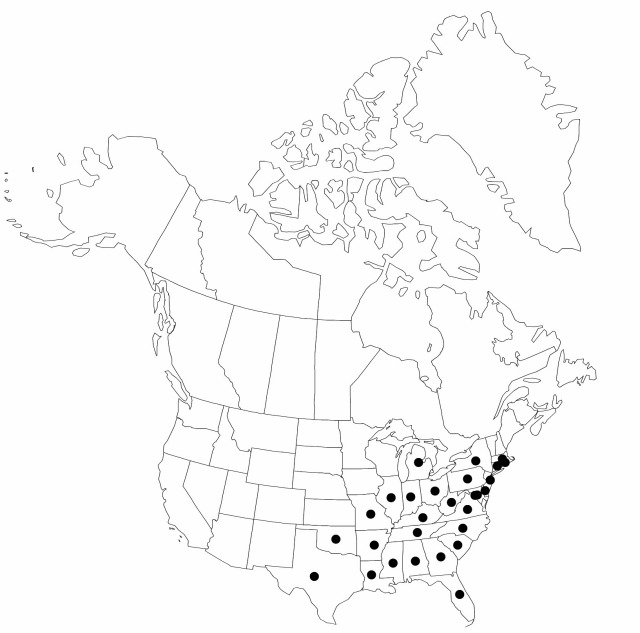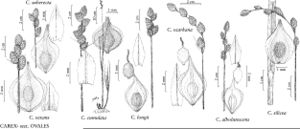Carex albolutescens
Ann. Lyceum Nat. Hist. New York 1: 66. 1824.
Plants densely cespitose. Culms 25–120 cm; vegetative culms inconspicuous with few leaves clustered at apex. Leaves: sheaths conspicuously green-veined adaxially nearly to apex, narrow hyaline band or sharp Y-shaped region at collar, adaxially firm, summits U-shaped, not prolonged; distal ligules 1.5–4.5 mm; blades 3–5 per fertile culm, 9–25 cm × 2–3.5 mm. Inflorescences erect, open, yellow-green to brown, 1.5–4 cm × 4–12 mm; proximal internode 3–12 mm; 2d internode 3–9 mm; proximal bracts scalelike, with bristle tips, shorter than inflorescences. Spikes 2–8, distinct, ellipsoid to globose, 5–13 × 4–6.5 mm, base acute, apex rounded; staminate portion of well-developed spikes less than 2 mm. Pistillate scales white-hyaline or brown, with green midstripe, broadly lanceolate or ovate, 2.5–3.4 mm, longer and narrower than perigynia, apex acute. Perigynia spreading, green to light brown, conspicuously 4–many-veined on each face, winged to base, obovate, flat except over achene or somewhat plano-convex, 2.6–4.5 × 1.5–2.7 mm, 0.3–0.45 mm thick, margin flat, including wing 0.4–0.7 mm wide; beak pale brown at tip, flat, ciliate-serrulate, abaxial suture with white or brown hyaline margin, distance from beak tip to achene 1–2 mm. Achenes oblong, 1.3–1.7 × 0.75–1 mm, 0.3–0.4 mm thick; styles laterally sinuate. 2n = 66.
Phenology: Fruiting early–mid summer.
Habitat: Acidic swamps, low woods, thickets
Elevation: 0–300 m
Distribution

Ala., Ark., Conn., Del., D.C., Fla., Ga., Ill., Ind., Ky., La., Md., Mass., Mich., Miss., Mo., N.J., N.Y., N.C., Ohio, Okla., Pa., R.I., S.C., Tenn., Tex., Va., W.Va.
Discussion
Carex albolutescens is easily confused with C. festucacea, which has orbiculate or broadly ovate, plumply plano-convex perignyia bodies, broader (usually more than 1 mm wide), more ovoid achenes, and straight or abaxial-adaxially bent styles (P. E. Rothrock 1991).
See note under 146. Carex longii.
Selected References
None.
